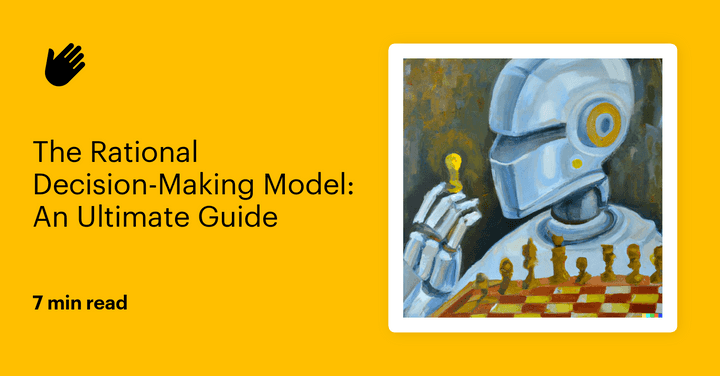The Rational Decision-Making Model: An Ultimate Guide

Everyone wants to make informed decisions that lead to the outcomes they want. But it’s easy to get caught up in emotions and always go with your gut feeling.
Your intuition is important — but if it’s your only source of truth, you’ll likely ignore relevant information when making big choices. That’s where rational decision-making comes into play.
In this article, we’ll break down what a rational decision-making model is, as well as steps and tips for making rational decisions.
What is the rational decision-making model?
The rational model of decision-making involves outlining a list of possible options, evaluating each one with objective knowledge, and deciding on a final course of action based on this reasoning. This model is often used in a business environment but can be applied to any important decision.
The difference between rational and intuitive decision-making
Rational decision-making relies on concrete objective information, while intuitive reasoning comes from emotions and feelings about past experiences. While both can be useful, intuitive decisions aren’t always the best solutions in business scenarios. Unconscious biases can lead to unfair treatment, and emotions can keep business leaders from considering every possible option.
An example of an intuitive decision-making style in the workplace might be hiring someone based on a gut feeling, even though there are other, more qualified candidates. While this gut feeling can pay off if it’s right, it ignores facts like previous work experience and hard skills that are usually determinants of a good job candidate.
5 steps in the rational decision-making model
The rational decision-making model begins with a problem, followed by multiple steps of analysis. Let’s say you have to choose between two potential clients because of a conflict of interest. You’d want to follow these steps to determine the best decision.
1. Identify the problem
Form a clear definition of what your problem is. In the example mentioned above, the problem is simple: Which client should you choose? Even in more complex situations, make sure you can label your problem in clear, simple terms.
Let’s say you’re assigned the task of helping a team member improve their work ethic. After looking into the issue, you might find that their work ethic is there, and the problem is actually that they don’t understand how to use other departments to close deals. In this case, the solution might be extra training — not pushing them to work harder.
2. Determine decision criteria
This step involves gathering all of the relevant information you’ll need to make your decision. Consider the following factors as starting points:
- Financial impact — How your decision affects you and your company in terms of monetary value.
- Client impact — How your decision will impact your relationships with existing clients.
- Coworker impact — How your decision will affect the people you work with.
- Personal impact — How your decision affects your personal well-being and career trajectory.
- Reputational impact — How your decision affects your reputation in your industry, as well as your company’s reputation.
- Precedential impact — How your decision affects future decisions. This is especially true in contract negotiations, where things you agree to can be used as precedents in the future.
- Cost impact — How your decision affects your money and other resources.
- Environmental impact — How your decision affects the environment.
These factors would all be important to consider when choosing between two potential clients. If one of these two potential clients was recommended by a current business partner, you might consider how your decision would affect that relationship. You might even need to take precedent into account; what is going to look like for your future reputation if you choose one possible alternative over the other?
3. Assess decision criteria
Once you’ve determined your decision criteria, rank them in order of importance. You might find that your long-term relationship with your customer who gave you a client referral far outweighs the other categories or that setting a sustainable precedent outweighs monetary gains.
Use this ranking to weigh the most important factors more heavily than others when deciding on your decision outcome.
4. Brainstorm solutions
Now that your information is organized, you can start brainstorming potential alternative solutions. Research how other similar cases in your industry played out and ask friends and coworkers how they’ve handled similar situations.
If you’re stuck, try to come up with BAD ideas to get them out of the way and get the process started. Approach the problem from the other party’s perspective, too, to come up with ideas — you might find that by considering their position, you can come up with a well-rounded solution.
Once you have a list of potential solutions, use your decision-making skills to write out pros and cons for each. Review these pros and cons based on your criteria. Note which ideas have pros in the areas you care about most to identify the most effective decision.
5. Make your final decision
This is the part where you make your final decision. Use these steps to land on the best alternative:
- Walk through the aftermath and consequences of each decision.
- Think about both the short- and long-term consequences of each.
- Weigh the pros and cons of each potential solution.
- Do a trial run where you imagine you make your decision. Are you happy with the outcome?
Choosing one client over the other might have good short-term benefits, but how will it affect your company in the long term? After careful analysis, you might find that the other client is the most well-connected client in your industry and that their partnership could lead to plenty of future business. Make sure to weigh your options to determine the better decision during this thought process.
Once you’ve run through these steps, you’ll be ready to make your final decision.
Tips to improve your decision-making process
The rational decision-making model is invaluable, but it can be challenging to follow. Sticking to objective information and considering all factors is easier said than done. The tips below will help you use solid reasoning and problem-solving, no matter what decision you’re facing.
1. Use research tools to do some of the work for you
To form rational decisions, you need to research possible solutions and their pros and cons. Make that process simpler by trying Heyday’s free trial.
Heyday is an AI-powered research assistant that reminds you of online content you’ve already read while you surf the web. People feel like they’re always losing context researching topics over and over again, and Heyday helps bridge that gap by recalling pages you’ve already visited. This means no more sifting through articles you’ve already read to find new information. Heyday helps you optimize your time on the web and get the most out of your web-surfing time.
2. Reflect on past rational decision
Look at your past rational decisions and see how the importance of your criteria (ranking, outcomes, consequences) has changed. What factors did you prioritize in the past, and did that prioritization pay off? You might realize that your priorities have changed or should change.
3. Take your time
Making rational decisions takes time. Don’t feel the need to rush yourself; make sure you have enough time to make your decision. After all, you’re the one who will have to live with the consequences. Rushed decisions might lead to the wrong outcome, which you can avoid if you take your time.
The best decisions happen when your brain is in tip-top shape
When you’re making difficult decisions, you want all the help you can get. Heyday’s ability to recall articles saves brain power and helps make your decision-making process easier. For example, while looking up productivity hacks, you might remember that you recently researched how to manage information overload, mental clutter, and infobesity. These articles popping up immediately will make your research process more efficient and save you time in the long run.
Run a smooth rational decision-making process.
Try Heyday for 14 days for free to improve your research process and overall mental growth.
